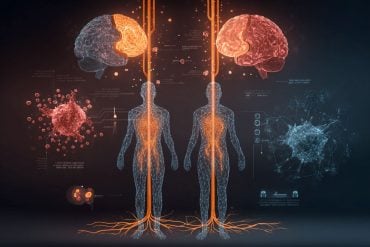Summary: Scientists have uncovered a dedicated brain circuit that distinguishes between direct fear and fear learned by observing others—known as vicarious fear. The study shows that the right side of the brainstem’s locus coeruleus (LC) activates a specific pathway to the anterior cingulate cortex (ACC) during vicarious fear, while the left side processes direct fear.
Disabling the right LC-ACC pathway in mice erased their vicarious fear response, revealing the brain’s lateralized design for emotional processing. These findings offer new insights into empathy, social learning, and potential treatments for disorders like psychopathy, social anxiety, and autism.
Key Facts:
- Lateralized Processing: The right brainstem (LC) regulates vicarious fear, while the left handles direct fear.
- Vicarious Fear Pathway: A specialized LC→ACC circuit activates only during observed distress in others.
- Therapeutic Insight: Findings may inform treatments for empathy-related psychiatric disorders.
Source: Institute for Basic Science
Have you ever felt a chill run down your spine while watching someone else in distress?
This phenomenon, known as vicarious fear, allows us to experience fear by observing others—even when we are not in direct danger ourselves. This aligns with the concept of ‘putting oneself in another’s shoes’—both figuratively and, as research suggests, even neurologically. Just as we metaphorically step into another’s place to understand their emotions, our brain processes fear vicariously when we witness someone else’s distress.

While essential for social learning and survival, the neural mechanisms distinguishing direct fear (from personal threats) and vicarious fear (from others’ distress) have remained a mystery—until now.
A research team led by Dr. SHIN Hee-sup at the Institute for Basic Science (IBS) has uncovered a fundamental brain circuit that distinguishes these two types of fear.
Their findings reveal that the locus coeruleus (LC), a small brainstem structure that produces norepinephrine (NA), plays a crucial role in processing fear—but in a lateralized manner, with the right and left hemispheres serving distinct functions.
For decades, scientists have studied how the brain processes fear, focusing primarily on regions like the amygdala and anterior cingulate cortex (ACC). The locus coeruleus (LC) has also been recognized as a key player in stress and fear responses.
However, until now, it was unknown whether the LC treats direct and vicarious fear as one and the same—or whether the brain has evolved distinct pathways for these different experiences.
Using advanced neuroscience techniques such as optogenetics (light-based neural control), fiber photometry (real-time neural activity measurement), and viral tracing (mapping brain connections), the researchers pinpointed a specialized neural circuit that selectively processes vicarious fear.
They hypothesized that the right-hemisphere LC connects to the ACC to regulate fear learned from others, while a separate pathway governs direct fear responses.
To test this idea, the team selectively inhibited neural pathways in mice and observed their behavioral responses. When a mouse saw another mouse receiving a mild foot shock—a model of vicarious fear—its right LC-ACC circuit became highly active.
However, when this pathway was silenced using optogenetics, the observing mouse no longer exhibited freezing behavior, a hallmark of fear. In contrast, deactivating the left-side LC had no effect on any of the fear responses.
Further experiments confirmed that this circuit relies on β-adrenergic receptors in the right ACC, as administering a beta-blocker (propranolol) also suppressed the vicarious fear response.
The researchers also traced the inputs to the LC, identifying two key upstream regions: the bed nucleus of the stria terminalis (BNST) and the central amygdala (CeA). Notably, the BNST→LC→ACC pathway was active only during vicarious fear, whereas the CeA→LC→BLA (basolateral amygdala) pathway was involved in both direct and vicarious fear, revealing a functional split in LC processing.
This study is the first to demonstrate that the LC-NA system is functionally lateralized—meaning the brainstem itself has distinct right- and left-side roles in emotional processing. It also sheds light on how the brain differentiates between “your fear” and “mine,” providing insights into the neural basis of empathy and social learning.
The findings have significant implications for understanding and treating fear-related psychiatric conditions. Disorders such as psychopathy, antisocial personality disorder, social anxiety, and autism spectrum disorder (ASD) involve disruptions in fear regulation and social cognition.
By identifying a dedicated neural circuit for vicarious fear, this research lays the groundwork for targeted therapies aimed at restoring normal fear processing in these conditions.
The study also contributes to a broader understanding of brain asymmetry—the idea that different sides of the brain handle different functions. While lateralization is well-known in language and motor control, this research shows that it also plays a role in emotional processing.
Looking ahead, the team plans to investigate whether similar pathways exist in the human brain. If so, this could bridge the gap between animal studies and clinical applications, potentially leading to new strategies for treating disorders related to fear and empathy.
By revealing how our brains distinguish between direct and observed fear, this study sheds new light on the biological basis of empathy and emotional learning. It offers exciting possibilities for developing treatments for psychiatric conditions and deepens our understanding of how emotions are wired into the brain.
About this neuroscience research news
Author: William Suh
Source: Institute for Basic Science
Contact: William Suh – Institute for Basic Science
Image: The image is credited to Neuroscience News
Original Research: Open access.
“The lateralized LC-NAergic system distinguishes vicarious versus direct fear in mice” by SHIN Hee-sup et al. Nature Communications
Abstract
The lateralized LC-NAergic system distinguishes vicarious versus direct fear in mice
Fear can be induced either directly through self-experience of aversive events or vicariously by observing conspecifics experiencing such events. The locus coeruleus-norepinephrine (LC-NA) system is crucial in fear responses and cognitive processes.
We investigated whether the LC-NA system differentially processes these two types of fear, direct and vicarious in male mice.
The results highlighted that the right hemisphere LC→anterior cingulate cortex pathway is uniquely crucial for vicarious fear, while the two inputs to the LC—from the bed nucleus of the stria terminalis (BNST) and the central amygdala (CeA)—differentially contribute to fear processing.
The BNST plays a more targeted role in vicarious fear, and the CeA has a broader influence on fear in general. This underscores the complexity and specialization within the LC-NA system for fear-processing.






